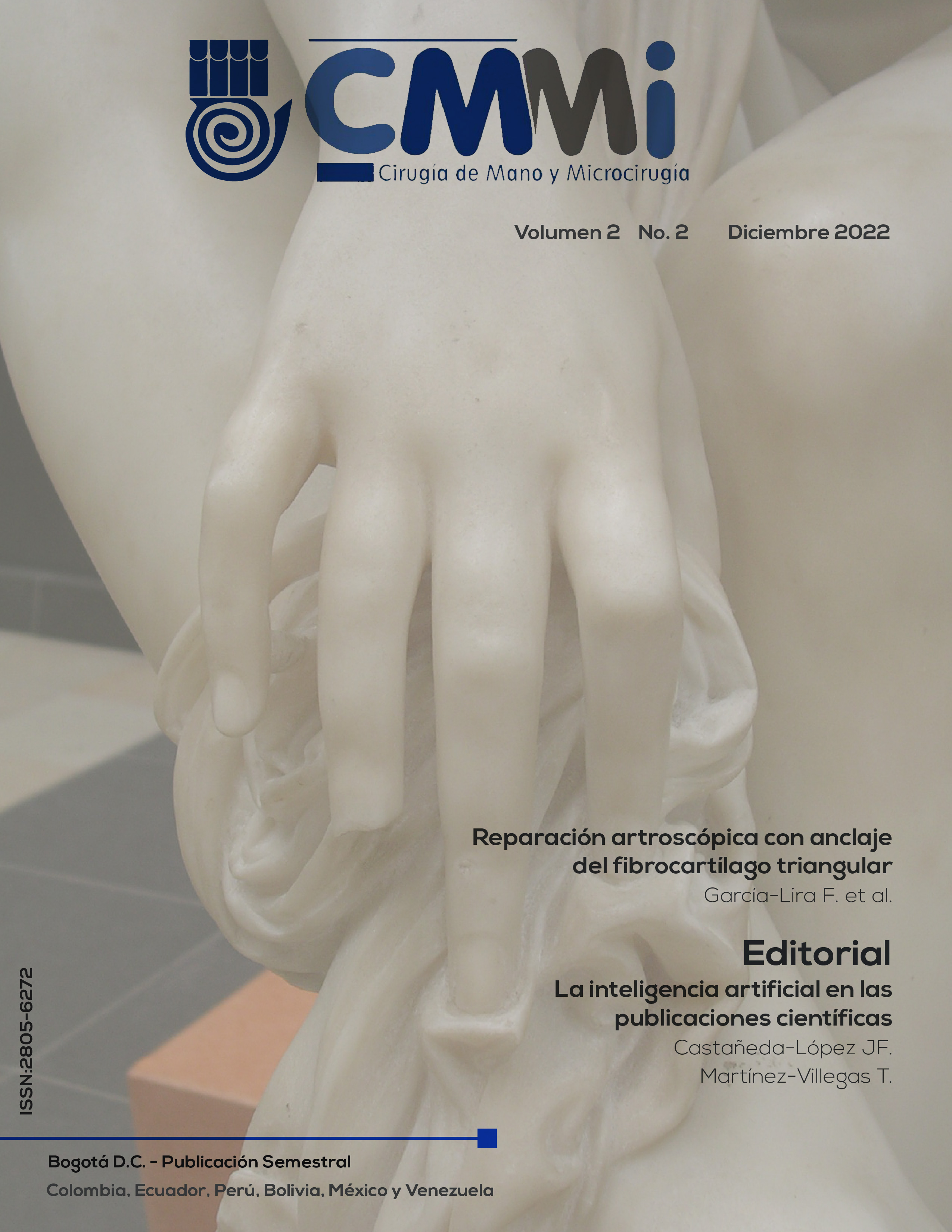Application of the “WALANT” technique in commonly used local flap surgeries for hand and finger coverage
DOI:
https://doi.org/10.25214/28056272.1657Keywords:
Hand Injuries, Surgical Flaps, Lidocaine, Epinephrine, AnesthesiaAbstract
Introduction. Different benefits have been demonstrated with the application of the WALANT
technique in the field of upper limb surgery, highlighting its simplicity, good results and reduction
in the costs of surgical treatment. Many upper limb surgical procedures are performed
daily with the use of Lidocaine / Epinephrine anesthesia. These procedures include coverage
of skin defects. However, this anesthetic technique has not been widely reported in this field.
The objective of this study is to report our experience in the realization and transfer of common
flaps for the coverage of fingers and hands with the use of t he WALANT technique.
Methods. Prospective, descriptive and follow-up study of a series of nine patients submitted to
different types of local flaps for hand and finger coverage with the WALANT technique.
Results. All patients underwent surgery without the use of a tourniquet. The average pain during
anesthesia, surgery and postoperative (E.V.A.) was 1.3. All flaps healed without complications.
The final functional result was Excellent in all patients in the study.
Conclusion. The WALANT technique in local flap surgery for the hand and fingers applied in
our study group, proved to be safe, reproducible, painless, effective, low cost and well accepted
by the patient.
Downloads
References
Lalonde D, Higgins A. Wide awake flexor tendon repair in the finger. Plast Reconstr Surg Glob Open. 2016;4(7):e797. DOI: 10.1097/GOX.0000000000000756.
Xing SG, Tang JB. Extending Applications of Local Anesthesia Without Tourniquet to Flap Harvest and Transfer in the Hand. Hand Clin. 2019;35(1):97-102. DOI: 10.1016/j.hcl.2018.08.009.
Denkler K. A comprehensive review of epinephrine in the finger: to do or not to do. Plast Reconstr Surg. 2001;108(1):114-24. DOI: 10.1097/00006534-200107000-00017.
Lalonde DH, Alison W. Dosage of Local Anesthesia in Wide Awake Hand Surgery. J Hand Surg Am. 2013;38(10):2025-8. DOI: 10.1016/j.jhsa.2013.07.017.
Lalonde D. Minimally Invasive Anesthesia in Wide Awake Hand Surgery. Hand Clin. 2014;30(1):1-6. DOI: 10.1016/j.hcl.2013.08.015.
Romo-Rodríguez R, Pareyón-Valero RP. Reparación de tendones flexores con WALANT: técnica quirúrgica y lesiones asociadas.
An Med (Mex). 2020;65(1):16-22. DOI: 10.35366/92913.
Tang JB. Wide-awake primary flexor tendon repair, tenolysis, and tendón transfer. Clin Orthop Surg. 2015;7(3):275-81. DOI: 10.4055/cios.2015.7.3.275.
McKee DE, Lalonde DH, Thoma A, Glennie DL, Hayward JE. Optimal time delay between epinephrine injection and incisión to minimize bleeding. Plast Reconstr Surg. 2013;131(4):811-4. DOI: 10.1097/PRS.0b013e3182818ced.
Xu J, Yin L, Cao S, Zhan H, Zhang J, Zhou Q, et al. Application of WALANT technique for repairing finger skin defect with a random skin flap. J Orthop Surg Res. 2021;16(1):164. DOI: 10.1186/s13018-021-02319-3.
McKee D, Lalonde D. Minimal pain local anesthetic injection with blunt tipped cannula for wide awake upper blepharoplasty. Plast Reconstr Surg Glob Open. 2017;5(5):e1310. DOI: 10.1097/ GOX.0000000000001310.
Downloads
Published
How to Cite
Issue
Section
License
Copyright (c) 2023 Cirugía de Mano y Microcirugía

This work is licensed under a Creative Commons Attribution 4.0 International License.
| Article metrics | |
|---|---|
| Abstract views | |
| Galley vies | |
| PDF Views | |
| HTML views | |
| Other views | |




